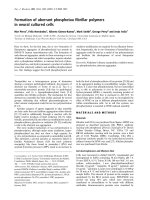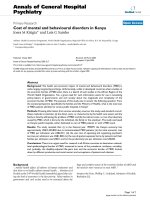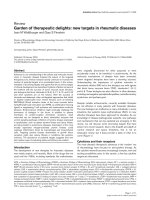Báo cáo y học: "Complications of continuous renal replacement therapy in children: are all created equal" docx
Bạn đang xem bản rút gọn của tài liệu. Xem và tải ngay bản đầy đủ của tài liệu tại đây (109.08 KB, 2 trang )
e treatment of acute kidney dysfunction in critically ill
children has advanced markedly in the past several
decades. Currently, continuous renal replacement therapy
(CRRT) and peritoneal dialysis form the mainstays of
treatment. However, there is little objective information
on patient outcomes and complications associated with
CRRT. Santiago and colleagues [1] have taken the
initiative to study CRRT complications and the factors
contributing to those complications in 174 critically ill
children treated from January 1996 to June 2009 at a
single pediatric intensive care unit. Complications
associated with catheterization, hypotension at the time
of CRRT connection, hemorrhage, and electrolyte distur-
bance in the fi rst 72 hours were analyzed. e authors
conclude that hypotension and electrolyte disturbances
are the most common CRRT complications in children.
e treatment of acute kidney injury in children has
been evolving over the past 20 years. In 1995, 45% of
pediatric centers used peritoneal dialysis and 18% used
CRRT for acute kidney injury. In 1999 that number was
reversed: 31% of centers used peritoneal dialysis, while
36% used CRRT [2]. is change may be associated with
the changing epidemiology of kidney injury (currently, the
leading causes of acute kidney injury in the pediatric
intensive care unit are a comorbidity/complication of
another disease such as congenital heart disease, nephro-
toxic medications, and sepsis) as opposed to primary renal
disease, which was the most common cause in the 1980s
[3,4]. e paper by Santiago and colleagues [1], identi fy ing
the complications of CRRT, is a unique and important step
in determining the risk/benefi t ratio of CRRT in children
and providing the sorely needed information upon which
to judge the appropriate use of CRRT. e data presented
can serve as the foundation for a future multicenter trial
assessing the utility of CRRT in children.
is study, like all good studies, has several important
limitations. A relatively small (174) number of children
were studied over a 13-year period at a single center,
limiting its generalizability. During this time, the clinical
management of critically ill children likely changed, which
could be a confounding factor in the study. For example,
as CRRT technology developed during the study, several
diff erent CRRT pumps were used. In addition, several
diff erent catheter sizes were used, which could impact
circuit viability.
Hypotension at dialysis onset is an important
complication of therapy, but could be related to multiple
factors, including how the patient was connected to the
circuit (either directly primed with saline or after purging
with heparin and fl ushed with albumin). is aspect of
the study is particularly unique in that hypotension with
dialysis onset is clinically accepted but its incidence
seldom reported. e high frequency of hypotension at
dialysis onset suggests that practitioners may need to
change how dialysis is started.
Another seldom-reported complication of dialysis,
elec trolyte abnormalities during CRRT, is also docu-
mented in this study. Unfortunately, electrolytes were
Abstract
Continuous renal replacement therapy (CRRT) in
pediatric acute kidney dysfunction has evolved in
recent decades; however, little objective data exist
for complications associated with CRRT. Santiago
and colleagues are among the rst to document
four complications of acute kidney dysfunction
in critically ill children: catheterization-related
insertion complications, hypotension, hemorrhage,
and electrolyte disturbances. They reported that
hypotension at connection (41.3%) and electrolyte
disturbance (50.6%) were the leading complications.
Although this study is limited by small sample size and
the outcome variables measured, it is an important
rst step in assessing outcomes of CRRT in children.
A prospective multicenter randomized trial will be
needed to fully delineate the complications and de ne
the risk/bene t ratio of CRRT in children.
© 2010 BioMed Central Ltd
Complications of continuous renal replacement
therapy in children: are all created equal?
Tina L Palmieri*
See related research by Santiago et al., />COMMENTARY
*Correspondence:
University of California Davis Regional Medical Center, Shriners Hospital for
Children Northern California, 2425 Stockton Blvd, Sacramento, CA 95817, USA
Palmieri Critical Care 2010, 14:105
/>© 2010 BioMed Central Ltd
monitored for only 72 hours, and the signifi cance of these
electrolyte abnormalities is not presented. An isolated
electrolyte abnormality does not necessarily constitute a
clinically signifi cant complication. Finally, fl uid balance
compli cations are intricately linked to electrolyte abnor-
malities as well as to mechanical ventilation and out comes,
but no data on fl uid-related complications are presented.
In summary, Santiago and colleagues have taken the
important fi rst step in evaluating the use of CRRT in
critically ill children: identifying complications of therapy.
is foundation study provides the baseline for future
multicenter prospective studies with the appropriate
statistical power to delineate fully the relative incidence
and severity of complications associated with CRRT.
Abbreviations
CRRT = continuous renal replacement therapy.
Competing interests
The author declares that she has no competing interests.
Published: 26 January 2010
References
1. Santiago MJ, Lopez-Herce J, Urbano J, Solana MJ, Del Castillo JD, Ballestero Y,
Botran M, Bellon JM: Complications of continuous renal replacement
therapy in critically ill children: a prospective observational evaluation
study. Crit Care 2009, 13:R184.
2. Warady BA, Bunchman T: Dialysis therapy for children with acute renal
failure: survey results. Pediatr Nephrol 2000, 15:11-13.
3. Bunchman TE, McBryde KD, Mottes TE, Gardner JJ, Maxvold NJ, Brophy PD:
Pediatric acute renal failure: outcome by modality and disease. Pediatr
Nephrol 2001, 16:1067-1071.
4. Hui-Stickle S, Brewer ED, Goldstein SL: Pediatric ARF epidemiology at a
tertiary care center from 1999 to 2001. Am J Kidney Dis 2005, 45:96-101.
Palmieri Critical Care 2010, 14:105
/>doi:10.1186/cc8229
Cite this article as: Palmieri TL: Complications of continuous renal
replacement therapy in children: are all created equal? Critical Care 2010,
14:105.
Page 2 of 2









